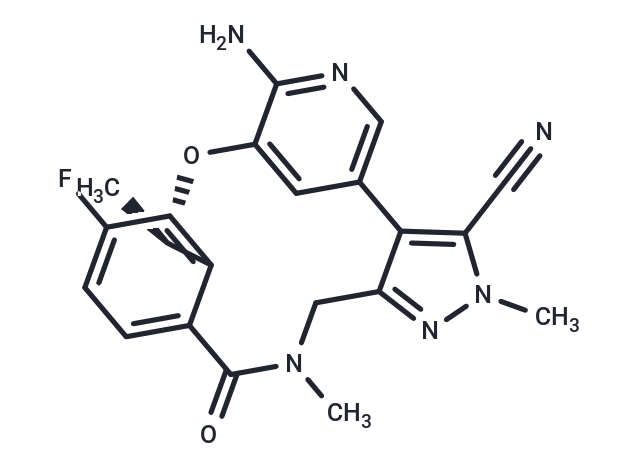Shopping Cart
- Remove All
 Your shopping cart is currently empty
Your shopping cart is currently empty

Lorlatinib (PF-6463922) is an orally available, ATP-competitive inhibitor of the receptor tyrosine kinases, anaplastic lymphoma kinase (ALK) and C-ros oncogene 1 (Ros1), with potential antineoplastic activity.

| Pack Size | Price | Availability | Quantity |
|---|---|---|---|
| 2 mg | $93 | In Stock | |
| 5 mg | $155 | In Stock | |
| 10 mg | $249 | In Stock | |
| 25 mg | $490 | In Stock | |
| 50 mg | $747 | In Stock | |
| 100 mg | $1,120 | In Stock | |
| 200 mg | $1,480 | In Stock |
| Description | Lorlatinib (PF-6463922) is an orally available, ATP-competitive inhibitor of the receptor tyrosine kinases, anaplastic lymphoma kinase (ALK) and C-ros oncogene 1 (Ros1), with potential antineoplastic activity. |
| Targets&IC50 | ROS1:<0.02 nM(Ki), ALK:<0.07 nM(Ki), TYK1/LTK:2.7 nM, ALK (L1196M):0.07 nM(Ki), FER:3.3 nM |
| In vitro | PF-06463922 effectively inhibits cell proliferation and induces apoptosis in HCC78 human NSCLC cells containing SLC34A2-ROS1 fusions and in BaF3-CD74-ROS1 cells expressing human CD74-ROS1. It also demonstrates this inhibitory action on cell proliferation and induces apoptosis in NSCLC cells with either non-mutated or mutated ALK fusions. PF-06463922 exhibits significant cellular activity against ALK and a wide range of ALK clinical mutations (IC50=0.2-77 nM). |
| In vivo | In NIH3T3 xenograft models expressing human CD74-ROS1 and Fig-ROS1, PF-06463922 inhibits cell proliferation by repressing ROS1 phosphorylation and downstream signaling molecules, including Cyclin D1. Furthermore, PF-06463922 demonstrates significant antitumor activity in mice bearing tumor grafts that overexpress EML4-ALK, EML4-ALK-L1196M, EML4-ALK-G1269A, EML4-ALK-G1202R, or NPM-ALK. |
| Kinase Assay | Recombinant human wild-type and mutant ALK kinase domain proteins (amino acids 1093–1411) are produced in-house using baculoviral expression, preactivated via autophosphorylation with MgATP, and assayed for kinase activity using a microfluidic mobility shift assay. The reactions contained 1.3 nM wild-type ALK or 0.5 nM mutant ALK (appropriate to produce 15-20% phosphorylation of peptide substrate after 1 h of reaction), 3 μM 5-FAM-KKSRGDYMTMQIG-CONH2), 5 mM MgCl2, and the Km level of ATP in 25 mM Hepes, pH 7.1. The inhibitors are shown to be ATP-competitive from kinetic and crystallographic studies. The Ki values are calculated by fitting the conversion (%) to a competitive inhibition equation. ROS1 enzyme is assayed as described above for ALK, except using 0.25 nM recombinant human ROS1 catalytic domain (amino acids 1883-2347). Kinase inhibitor selectivity is evaluated using a 206-kinase panel. |
| Cell Research | Cells are seeded in 96-well plates in growth medium containing 10% FBS and are cultured overnight at 37°C. The following day, serial dilutions of PF-06463922 or appropriate controls are added to the designated wells, and cells are incubated at 37°C for 72 h. A CellTiter-Glo assay is performed to determine the relative cell numbers. IC50 values are calculated by concentration-response curve fitting using a four-parameter analytical method. |
| Alias | PF-6463922, PF-06463922, Loratinib |
| Molecular Weight | 406.41 |
| Formula | C21H19FN6O2 |
| Cas No. | 1454846-35-5 |
| Smiles | C[C@H]1Oc2cc(cnc2N)-c2c(CN(C)C(=O)c3ccc(F)cc13)nn(C)c2C#N |
| Relative Density. | 1.42 g/cm3 (Predicted) |
| Storage | keep away from moisture,store under nitrogen,store at low temperature | Powder: -20°C for 3 years | In solvent: -80°C for 1 year | Shipping with blue ice. | |||||||||||||||||||||||||||||||||||
| Solubility Information | Ethanol: 40.6 mg/mL (99.9 mM), Sonication is recommended. DMSO: 15 mg/mL (36.91 mM), Sonication is recommended. | |||||||||||||||||||||||||||||||||||
Solution Preparation Table | ||||||||||||||||||||||||||||||||||||
DMSO/Ethanol
Ethanol
| ||||||||||||||||||||||||||||||||||||

Copyright © 2015-2025 TargetMol Chemicals Inc. All Rights Reserved.